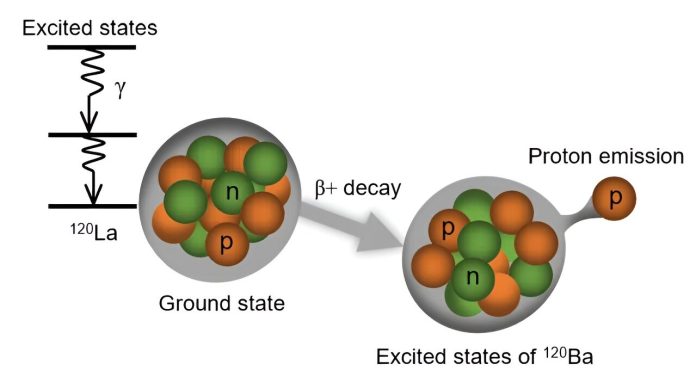
For the first time, physicists have observed excited states in lanthanum-120, a very neutron-deficient and rare type of atomic nucleus.
This groundbreaking study was published in Physics Letters B and conducted by researchers from the Institute of Modern Physics (IMP) of the Chinese Academy of Sciences, along with collaborators from France, Finland, South Africa, and other countries.
Lanthanum-120 is an unusual and rare isotope, discovered in 1984, known for being a β-delayed proton emitter.
However, because it is produced in extremely low quantities, identifying and studying it has been a significant challenge.
For the past 40 years, scientists struggled to measure its excited states, which are crucial for understanding its structure and behavior.
As nuclei, which are the central parts of atoms, get closer to having equal numbers of protons and neutrons (the N=Z line), the interaction between protons and neutrons becomes stronger.
This interaction can change the shapes of the nuclei, making them look like different objects such as a rugby ball, pancake, pear, or kiwi.
Assoc. Prof. Lyv Bingfeng from IMP, one of the lead authors of the study, emphasized the importance of measuring these excited states to uncover the mechanisms behind the structure of extremely proton-rich lanthanum nuclei.
To study lanthanum-120, researchers used advanced equipment, including a mass separator and high-efficiency gamma detector arrays, at the University of Jyvaskyla in Finland.
This setup allowed them to successfully identify and measure the excited states of lanthanum-120 for the first time.
They discovered that the energies of gamma rays, which are a type of radiation emitted by the nucleus, follow a specific pattern when comparing odd and even spins (a property related to the nucleus’s angular momentum). They also found a unique staggering pattern in transition probabilities, which is different from those seen in nearby nuclei.
Costel Petrache from the University of Paris-Saclay in France, another lead author of the study, explained that their data, combined with theoretical models, indicate that lanthanum-120 has a pronounced triaxial deformation.
This means it has a unique, three-dimensional shape. Additionally, the study suggests that the interaction between protons and neutrons is essential for understanding the structure of similar odd-odd nuclei (nuclei with an odd number of protons and neutrons) near the proton drip line, a region where nuclei are very unstable and tend to lose protons.
This research marks a significant step forward in nuclear physics, providing new insights into the behavior and structure of rare, neutron-deficient nuclei like lanthanum-120.
It also highlights the importance of proton-neutron interactions in shaping these unique atomic structures.
Source: Chinese Academy of Sciences.



